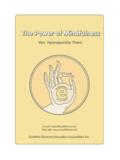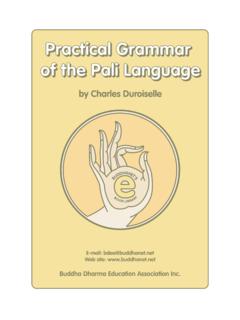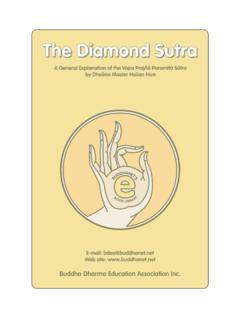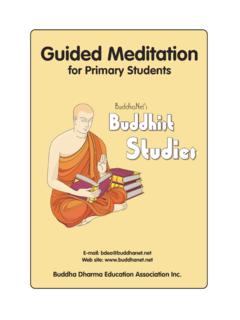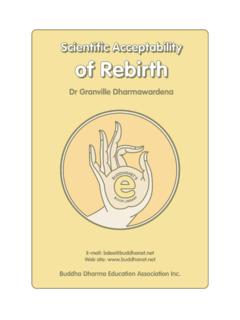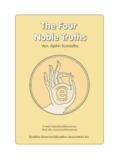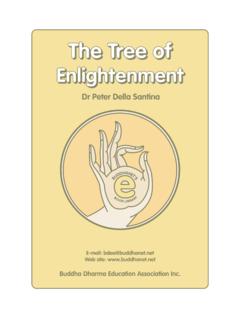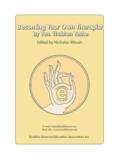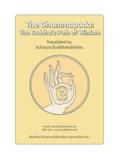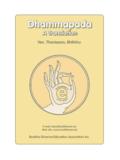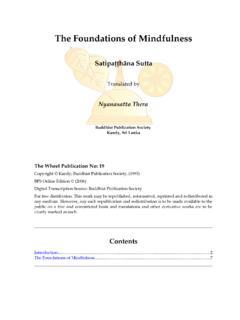Transcription of The Noble Eightfold Path - Buddhism
1 The Noble Eightfold path The The Way Way to to the the End End of of Suffering Suffering by Bhikkhu Bodhi e DHANET. UD '. B. S. BO Y. O K LIB R A R. E-mail: Web site: Buddha Dharma Education Association Inc. The Noble Eightfold path The Way to the End of Suffering by Bhikkhu Bodhi Source: The Wheel Publication No. 308/311 (Kandy: Buddhist Publication Society, 1984), second edition (revised) 1994. Tran- scribed from a file provided by the BPS. Copyright 1998 Buddhist Publication Society Access to Insight edition 1999. For free distribution. This work may be republished, reformatted, reprinted, and redistributed in any medium.
2 It is the author's wish, however, that any such republication and redistribution be made available to the public on a free and unrestricted basis and that translations and other derivative works be clearly marked as such. Contents Preface .. v Abbreviations .. vii Chapter I. The Way to the End of Suffering .. 1. The Range of Suffering .. 6. The Causes of Suffering .. 7. Cutting Off the Causes of Suffering .. 9. Chapter II. Right View .. 12. Mundane Right View .. 15. Superior Right View .. 21. Chapter III. Right Intention .. 26. The Intention of Renunciation .. 30. The Intention of Good Will.
3 33. The Intention of Harmlessness .. 37. iii Chapter IV. Right Speech, Right Action, Right Livelihood .. 40. Right Speech (samma vaca) .. 43. Right Action (samma kammanta) .. 49. Right Livelihood (samma ajiva) .. 55. Chapter V. Right Effort .. 57. Chapter VI. Right Mindfulness .. 70. Chapter VII. Right Concentration .. 86. The Development of Concentration .. 87. The Stages of Concentration .. 90. Chapter VIII. The Development of Wisdom .. 98. Epilogue .. 110. Appendix .. 111. Recommended Readings .. 113. About the Author .. 115. iv Preface T he essence of the Buddha's teaching can be summed up in two principles: the Four Noble Truths and the Noble Eightfold path .
4 The first covers the side of doctrine, and the pri- mary response it elicits is understanding; the second covers the side of discipline, in the broadest sense of that word, and the primary response it calls for is practice. In the structure of the teaching these two principles lock together into an indivisible unity called the dhamma-vinaya, the doctrine-and-discipline, or, in brief, the Dhamma. The internal unity of the Dhamma is guaranteed by the fact that the last of the Four Noble Truths, the truth of the way, is the Noble Eightfold path , while the first factor of the Noble Eightfold path , right view, is the understand- ing of the Four Noble Truths.
5 Thus the two principles pene- trate and include one another, the formula of the Four Noble Truths containing the Eightfold path and the Noble Eightfold path containing the Four Truths. Given this integral unity, it would be pointless to pose the question which of the two aspects of the Dhamma has greater value, the doctrine or the path . But if we did risk the pointless by asking that question, the answer would have to be the path . The path claims primacy because it is precisely this that brings the teaching to life. The path translates the Dhamma from a collection of abstract formulas into a continually unfolding dis- closure of truth.
6 It gives an outlet from the problem of suffer- ing with which the teaching starts. And it makes the teaching's goal, liberation from suffering, accessible to us in our own expe- rience, where alone it takes on authentic meaning. To follow the Noble Eightfold path is a matter of practice rather than intellectual knowledge, but to apply the path cor- rectly it has to be properly understood. In fact, right understand- ing of the path is itself a part of the practice. It is a facet of right view, the first path factor, the forerunner and guide for the rest . of the path . Thus, though initial enthusiasm might suggest that the task of intellectual comprehension may be shelved as a both- ersome distraction, mature consideration reveals it to be quite essential to ultimate success in the practice.
7 The present book aims at contributing towards a proper understanding of the Noble Eightfold path by investigating its eight factors and their components to determine exactly what they involve. I have attempted to be concise, using as the frame- work for exposition the Buddha's own words in explanation of the path factors, as found in the Sutta Pitaka of the Pali Canon. To assist the reader with limited access to primary sources even in translation, I have tried to confine my selection of quotations as much as possible (but not completely) to those found in Ven- erable Nyanatiloka's classic anthology, The Word of the Buddha.
8 In some cases passages taken from that work have been slightly modified, to accord with my own preferred renderings. For fur- ther amplification of meaning I have sometimes drawn upon the commentaries; especially in my accounts of concentration and wisdom (Chapters VII and VIII) I have relied heavily on the Visuddhimagga (The path of Purification), a vast encyclopedic work which systematizes the practice of the path in a detailed and comprehensive manner. Limitations of space prevent an exhaus- tive treatment of each factor. To compensate for this deficiency I. have included a list of recommended readings at the end, which the reader may consult for more detailed explanations of indi- vidual path factors.
9 For full commitment to the practice of the path , however, especially in its advanced stages of concentration and insight, it will be extremely helpful to have contact with a properly qualified teacher. Bhikkhu Bodhi vi Abbreviations Textual references have been abbreviated as follows: DN Digha Nikaya (number of sutta). MN Majjhima Nikaya (number of sutta). SN Samyutta Nikaya (chapter & number of sutta). AN Anguttara Nikaya (numerical collection & number of sutta). Dhp Dhammapada (verse). Vism Visuddhimagga References to Vism. are to the chapter and section number of the translation by Bhikkhu anamoli, The path of Purification (BPS ed.)
10 1975, 1991) Y. vii Chapter I. The Way to the End of Suffering T he search for a spiritual path is born out of suffering. It does not start with lights and ecstasy, but with the hard tacks of pain, disappointment, and confusion. However, for suffering to give birth to a genuine spiritual search, it must amount to more than something passively received from without. It has to trigger an inner realization, a perception which pierces through the facile complacency of our usual encounter with the world to glimpse the insecurity perpetually gaping underfoot. When this insight dawns, even if only momentarily, it can precipitate a profound personal crisis.
